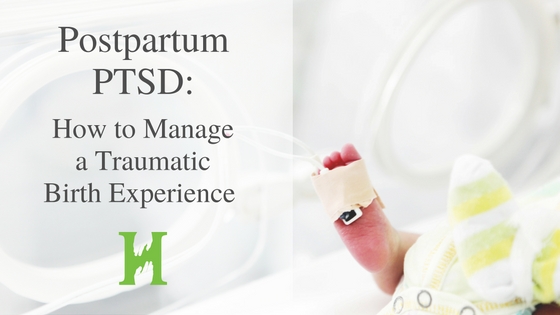The following post is the third installment of a three-part series on PPD and PTSD in NICU parents. Visit part 1, Postpartum Depression and PTSD in Fathers, and part 2, Postpartum Depression After a Complicated Delivery.

A Traumatic Delivery
It might surprise you to learn that one third of women describe their labor and delivery experience as traumatic. Interestingly, research shows that some women view their childbirth experience as traumatic (meaning viewing it as having threatened their life or their baby’s) even when objectively this was not the case, while others who may have had complications that did in fact place them or their baby at risk do not feel traumatized. The point is that the subjective experience is essential – the view by mom, not by doctors.
One of the main circumstances that can make the experience of labor feel traumatic is the loss of control. Often times, women have specific plans for delivery, and just as often, things do not go according to plan. This loss of control can make a person feel very vulnerable and lead to the perception that the delivery was a negative experience.
Postpartum PTSD
PTSD is a condition that occurs after a stressful life event and includes the following symptoms:
- Avoidance of reminders of the event
- Intrusive thoughts or re-experiencing of the trauma
- Irritability
- Difficulty concentrating
- Changes in arousal (such as being more easily startled) and vigilance (such as being more alert and cautious of surroundings)
- Negative changes in thoughts and mood
PTSD has been diagnosed in 1-9% of women after childbirth, with persistence of the diagnosis well into the postpartum period. In fact, several studies show that the prevalence of PTSD during the postpartum period peaks around 3-6 months. However, many women may still be struggling psychologically and emotionally, yet might not meet the technical criteria of PTSD.
How to Reduce the Chance of Postpartum PTSD
Feeling out of control and lost during delivery can increase the risk of postpartum PTSD. To decrease this risk, it is important to advocate for yourself (consider perhaps hiring a doula) and learn as much as possible in advance about all potential interventions. This could be with additional visits with your obstetrician or taking a class. A full delivery room with a large medical staff can be stressful and confusing. Getting introductions and learning everyone’s role can decrease that anxiety. Finally, co-occurring anxiety or depression can increase the risk of postpartum PTSD. It is essential to ensure these conditions have been addressed.
How to Treat Postpartum PTSD
If you think you might be struggling with symptoms of postpartum PTSD, the good news is that this is quite treatable. The best treatment that we have for post-traumatic stress disorder is psychotherapy. Therapy will help you process the event, move past the trauma, and learn skills to manage symptoms. There are many different kinds of psychotherapy, but those that have been studied best for PTSD include cognitive-behavioral therapy, exposure treatment, and eye movement desensitization and reprocessing (EMDR). Medications can also play in role in helping with the symptoms of anxiety and difficulty with sleep. I recommend connecting with your obstetrician, pediatrician, or primary care physician to obtain recommendations for a good mental health provider.
 About Dr. Glezer:
About Dr. Glezer:
Anna Glezer, MD is a Harvard-trained clinician with current joint appointments in the reproductive psychiatry and OB/GYN departments at UCSF Medical Center. She is the founder of Mind Body Pregnancy, a new online educational resource that helps women with their emotional well-being and mental health during pregnancy, delivery, and postpartum.
